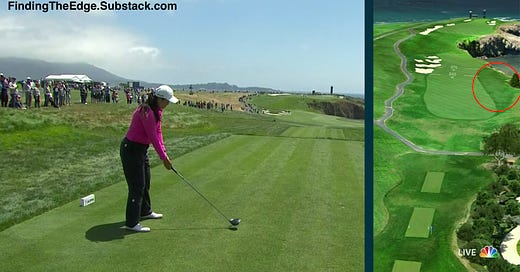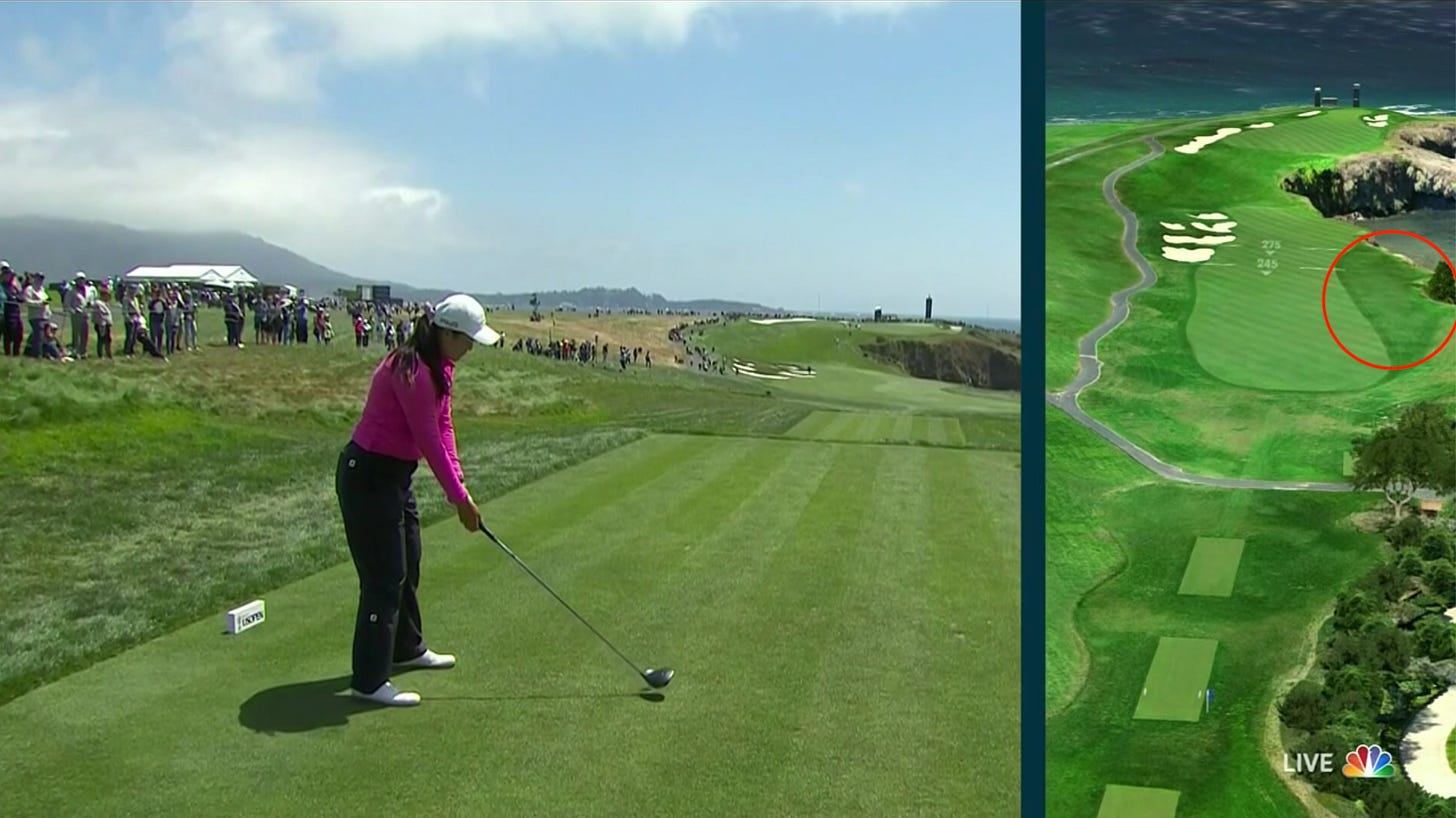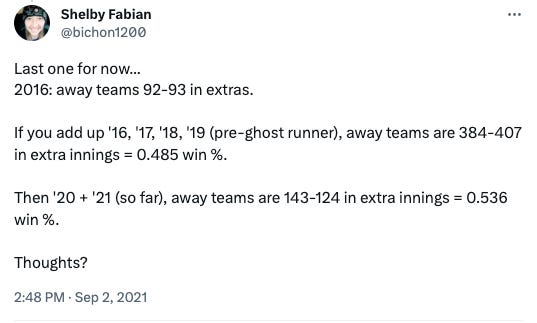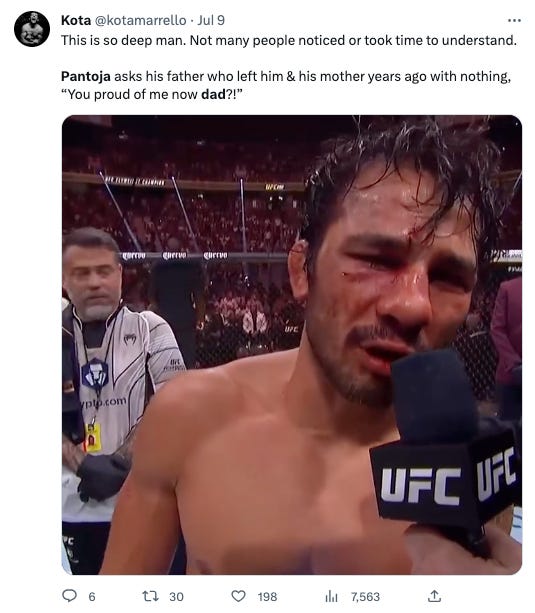Pebble Beach
Pebble Beach Golf Links, one of the most iconic golf courses in the world, hosted its first U.S. Women’s Open this past weekend. The tournament was a spectacular display of championship golf and equity, falling short in only one dimension: course setup.
Before getting into how the USGA botched the setup, it’s important to provide context for those unfamiliar with the subject. Golf course architecture is a beautiful subject matter, yet it is not always the easiest topic to digest. Understanding course design and how it enables brilliant golf requires critical thinking, data collection (even if the data is only collected with your eyes!), and open-mindedness when exposed to new information. We shouldn’t assume that, based on someone’s job title or stature within the sport, he or she has a robust understanding of how to design and set up a golf course. After all, some highly accomplished golfers like Jack Nicklaus and Greg Norman have built a multitude of horrendous golf courses.
Garrett Morrison’s breakdown of the 10th hole provides insight into the design of one of Pebble Beach’s best holes:
The elegance of Pebble Beach is that creative, daring architectural principles converge with some of the most magnificent land in the country. Shamefully, the USGA neutered some of that elegance this past week.
The sixth hole is one of the most stunning par 5s in golf. It’s also a strategic golf hole, especially for female professional golfers. The women hit the ball considerably shorter than male professional golfers, which shrinks their dispersion patterns. Though I wouldn’t advise any professional golfer to challenge penalty hazards, the women’s game lends itself to playing closer to hazards than the men’s game: a shot traveling 260 yards is easier to control than a shot traveling 310 yards.
Hole 6 at Pebble Beach provides a strategic advantage for players who find the right side of the fairway, close to the ocean. The fairway slopes from left to right. Players who find the right side of the fairway are rewarded with flatter lies compared to the players who find the left side of the fairway, which is beneficial on the long approach shot into the green. The lie advantage is particularly significant for women, as they are often hoisting fairway woods up and over the cliff on their second shots. Hitting a fairway wood from a flat lie is much easier than hitting with the ball below your feet.
Instead of allowing the hole to play as intended, the USGA inserted a strip of rough down the right side, prohibiting players from playing near the penalty area.
Contrast the visual above with the untarnished version of the sixth hole below. Notice how the fairway creeps right up to the edge of the penalty area down the right?

The USGA will argue that narrowing the fairways rewards driving accuracy. I’d counter that the inserted patch of rough stops errant tee shots from leaking over the cliff and into the ocean, bailing out inaccurate drives. More importantly, the contrived rough compromises the strategy of the hole, reducing a player’s options off the tee and channeling all tee shots into the same narrow corridor.
The narrowing of Hole 8 might have been equally repulsive:
Even if you don’t know much about golf or have never seen Pebble Beach before, you can probably visualize that the fairway is supposed to extend farther to the right than how it is presented in this picture. Why would the original architects waste such a valuable opportunity to steer players toward such a scenic, dramatic natural feature? They didn’t.
If your reaction is that my complaining is much ado about nothing, I think it is important to consider the underlying philosophy that leads to contriving a setup in this fashion. Far too many people in golf concern themselves with scores instead of prioritizing shot value. That is a pervasive problem within the golf world. It is not unique to the U.S. Women’s Open at Pebble Beach.
Entering the PGA Championship at Oak Hill, Buffalo Bills quarterback Josh Allen expressed a common sentiment: he was eager to see the best golfers in the world struggle on his home course. Oak Hill was a long, narrow, firm golf course with fairways that often required luck to hit.
Is that an attractive brand of golf? Is that really what you want?
Additionally, wide misses were not penalized heavily at Oak Hill. Impossible-to-hit fairways combined with small penalties for wide misses made for an ugly recipe. It is not a coincidence that long-hitting, often errant drivers like Bryson DeChambeau and Rory McIlroy finished near the top of the leaderboard at the PGA Championship. It is also not a coincidence that Michael Block, a PGA club professional with zero success in elite professional golf tournaments, finished tied for 15th at Oak Hill. I can assure you that Michael Block would not sniff the cut line at Augusta National, a golf course with corridors wide enough to accommodate the modern game.
Proper accuracy tests with wide fairways are far superior to courses that only test players’ accuracy with narrow corridors and thick rough. Thick rough stops errant balls from rolling into trouble. The sport is most compelling when players must control the ball on the ground, which requires clever contouring and wide areas of short grass. Eventually, the golf world will realize that the best setups in professional golf are wide, strategic, and demanding.
I suppose there’s a compelling story to tell about the history of golf and how courses have been lengthened to accommodate the modern game without being widened. The farther you hit the golf ball, the farther the ball travels forward but also left and right. As golf courses have been rendered obsolete by modern technology and athleticism, courses have searched tirelessly for land and have devoted inordinate amounts of resources to extend their golf courses. Generally, extending a golf course only involves adding a tee box behind the existing tee boxes. To my knowledge, fairways are seldom widened during that effort. Perhaps there is a case to be made that simply lengthening a course without widening the playing corridors results in a mismatch between players’ shot patterns and proper playing dimensions.
Oh, and then when it’s clear that a golf course has been outgrown and out-technologied, equipment manufacturers and many pro golfers suggest narrowing the fairways and growing up the rough.
Bear in mind that this is the same contingent typically decrying any mention of rolling equipment back. I guess you have to compromise the quality of the sport to bring scoring back to equilibrium. Why solve the root issue? Modernizing the men’s game is quite a vicious cycle.
Fortunately, the women’s game fits the dimensions of golf courses much better than the men’s game. Even still, the USGA could not get out of its own way this past week, succumbing to narrow-mindedness instead of letting the magnificence of Pebble Beach stand on its own 18 feet.
I’m not complaining about narrow-mindedness for the sake of complaining. I want to see the game evolve in a positive direction. Golf is a terrific sport: an enthralling blend of skill, commitment, mental toughness, and strategy. When presented properly, all four of those attributes are elevated. Narrow-minded decision-makers stand in the way. I’m looking forward to the day when professional golf is presented at its full potential.
The future is wide open.
Extra Innings
A week ago I celebrated the Fourth of July evening second-hand sweating the final leg of my cousin’s MLB parlay: a tradition unlike any other.
Tied through regulation, the Braves-Guardians game went into extra innings. It gave me the opportunity to consider a question I’ve been pondering for a few weeks: whom do the rules favor in extra innings?
Beginning in 2020, the MLB instituted a rule change pertinent only to the regular season. In extra innings, teams start with a runner on second base and zero outs. You might assume that, given both teams start with a runner in the same position, neither team is advantaged. I believe that is wrong.
Given that the home team bats second and knows exactly how many runs it needs to score to win the game, you might assume the home team has an advantage. For example, imagine that the away team does not score in the top of the 10th inning. The home team needs to score just one run to win. If it is optimal to bunt the runner over to third in that situation, then the home team reaped a significant informational advantage. They’d never bunt the runner over if they needed to score multiple runs to win, so the informational advantage was actionable. The away team can never bunt the runner over to third in the top half of the inning because they don’t know how many runs are needed to win the game. Imagine if the away team scored one run in the top half, followed by the home team hitting a two-run home run to end the game in the bottom half of the inning. Optimizing on scoring at least one run does not make sense for the away team. Thus, the home team has an informational advantage. That logic was my initial intuition. But I believe that is also wrong.
I’m far from an expert on baseball but my understanding is that bunting is rarely optimal. There are probably not many instances where bunting is optimal and those instances likely arise infrequently. Outside of bunting, the hitting team does not have many adjustments it can make. On the other side of the ball, the fielding team can make quite a few adjustments.
During the aforementioned Braves-Guardians game, the Braves failed to score in the top of the 10th despite starting with a runner on second base. To begin the bottom of the 10th inning, the Braves intentionally walked the first batter, giving themselves the opportunity to turn a double play on a ground ball.
(Important note: The home team could never intentionally walk the first batter in the top of the 10th inning. If the next batter hits a three-run home run, you’re dead. This specific defensive adjustment only applies for the away team because they’re optimizing on preventing a single run. No other runs matter.)
It worked. The Guardians bunted into a double play. Bunting isn’t easy! Ok so now, the Guardians have a runner on third base with two outs, needing one run to win the game. Then, the Braves intentionally walked yet another batter, presumably to target a favorable matchup with the next batter. See how many opportunities the Braves had to make advantageous decisions?
All right, they still lost the game. The next hitter hit a line drive to left field and the Guardians won. However, this is a process-oriented newsletter, and I hope you can see the informational advantages associated with being the away team. The Braves strategically put themselves in a strong position to escape the inning. They couldn’t have done so as the home team.
The fundamental question is whether there’s more value to defensive adjustments or offensive adjustments. I lean heavily towards defensive, so I believe the away team benefits from the extra innings rules.
What does the data tell us?
It’s hard to say. I don’t have the data to verify, but I found this tweet posted in September of 2021 that indicates a significant advantage for the away team:
I texted a member of an MLB analytics department about this, and he wasn’t aware of any existing research on the topic. He also noted that I should be cautious interpreting past game results, like the tweet above, because teams may not be making decisions optimally. So while the above tweet suggests that away teams *should* win in extra innings 54% of the time, the true number could be higher (or lower) if all teams made decisions optimally (i.e. intentionally walk, bring outfielders in, etc.).
I believe the away team has a significant advantage, and it would be interesting to see if Las Vegas markets reflect this edge. In theory, away teams should be smaller underdogs post 2020 than leading up to 2020, ceteris paribus. The effect should be strongest for small underdogs, as those games are more likely to go to extra innings than if a team is expected to lose by a more significant run margin. It would not surprise me if there’s a betting edge in identifying teams that act optimally in extra innings and betting them as the away team against similarly-rated opponents. Perhaps the edge is too small to action upon.
Whether or not this specific edge is actionable, this is a good example of leveraging information to one’s advantage. Smart people within the Braves organization are not questioning their decision to intentionally walk batters if it gave them the best chance of winning. Evaluate on process, not result.
Similarly, the smartest decision-makers in golf leverage numbers and concepts to their advantage. Strategically-sound players like Scottie Scheffler and Viktor Hovland don’t second guess their decisions based on their results. They remain aggressive on (most) tee shots and conservative on (most) approach targets. They intentionally walk when it is optimal.
And that’s why they start most tournaments with a runner on second base.
Do the Research
If you’d like to do a rigorous analysis evaluating the theoretical advantage of away teams in extra innings, I’d love to publish your results in a future edition of Finding the Edge. Five Hundred FedEx Cup points will be given to the top entrant. If I get a strong field with a bunch of qualified entrants, Five Hundred FedEx Cup points will be given to the top entrant.
Feedback/Contact
Twitter: @JosephLaMagna
Email: Joseph.LaMagnaGolf@gmail.com
Other Recent Content
I went on the Fried Egg Golf Podcast with Andy Johnson last Thursday to discuss how Pebble would play for the women and some notes on the PGA Tour season. Still relevant!
Despite no threat of an “irrational actor,” the NBA is improving its product.
Through implementation of a pitch clock, the MLB has also improved its product:
UFC 290 was absolutely incredible. This clip of Alexandre Pantoja was…powerful:
Ukrainian tennis players have elected to refrain from shaking hands with Russian/Belarusian players. Since the Russian invasion, Russian & Belarusian athletes have been treated very disrespectfully by fans and media. This week Belarusian Victoria Azarenka was booed off the court after losing to Ukrainian Elina Svitolina in a thrilling match. I enjoyed her comments here:
I’ve started following Sally Jenkins after finding her recent Twitter commentary on the PGA Tour-LIV merger insightful. I stumbled across her 2019 eulogy for her father, the legendary sports writer Dan Jenkins. It’s a delightful read.











